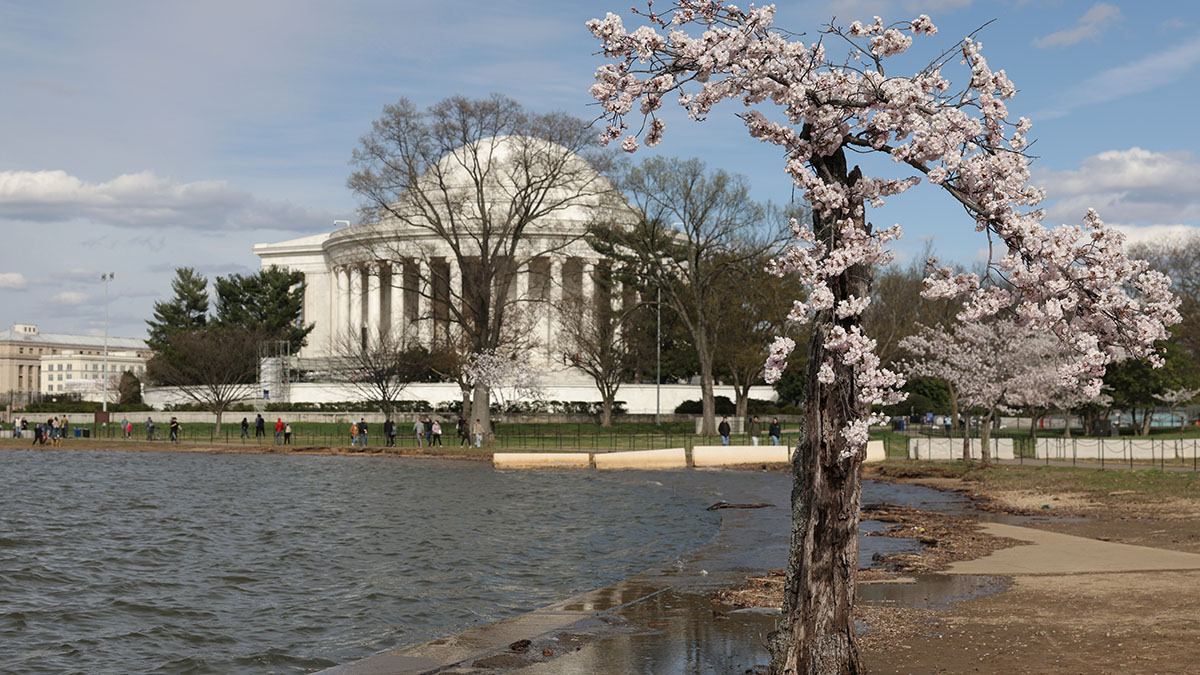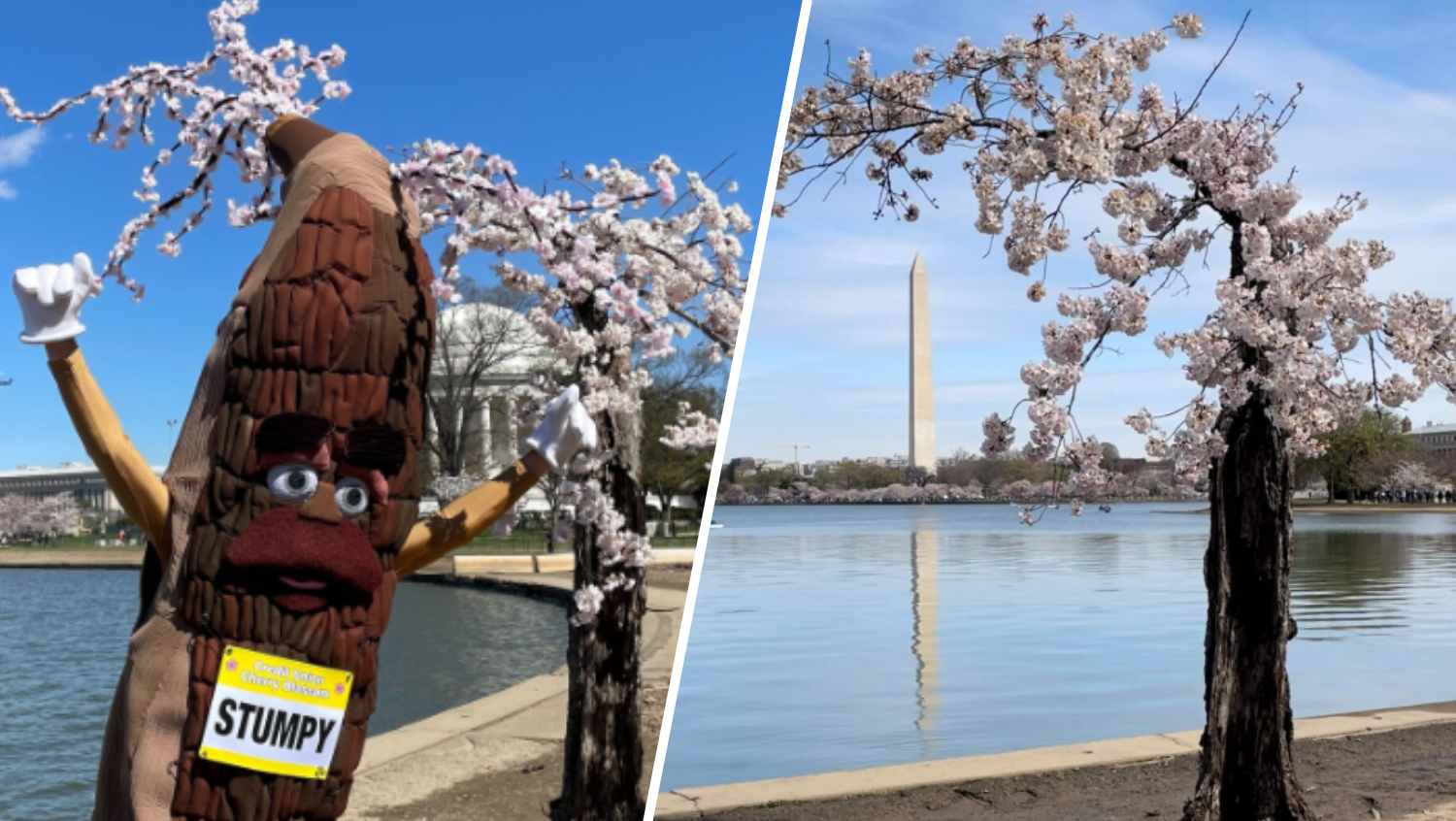
As cherry blossom season comes to an end and petals start to blanket D.C.’s streets, it’s worth noticing the cherry trees’ resilience. These trees have seen it all, from flooding and harsh winds to hoards of visitors each year.
The average lifespan for a cherry tree is about 40 years, but many trees in the District and surrounding areas are living far beyond that — in part because of the round the clock care they receive — even as they face threats from their own environments. Some of the cherry trees that line the Tidal Basin are estimated to be over 100 years old. They have survived rising sea levels and the soil around their roots being trampled by millions of people.
“It's kind of remarkable, but you know, 112 years later, a lot of these trees have sort of adapted to that environment,” said National Park Service spokesman Mike Litterst.
At the American University (AU) Arboretum, four cherry trees were initially planted in 1943 by Syngman Rhee – who would eventually become the first president of South Korea – as a gift from the Korean Women's Relief Society of Honolulu. More than 80 years later, the AU Arboretum cares for more than 200 cherry trees, and three of the four original trees are still standing and reliably blooming each year.
We're making it easier for you to find stories that matter with our new newsletter — The 4Front. Sign up here and get news that is important for you to your inbox.
“Trees are surprisingly resilient to their surroundings…” said Mike Mastrota, the AU Arboretum manager. "But the cherries in particular, I think, tend to be pretty hardy in this area.”
Here's a look at how D.C.'s famous cherry trees thrive in the face of natural and manmade threats.
The hazards of climate change, heat and too much salty water
Cherry blossoms in the District have lived through a multitude of climate change-related challenges over the years.
Heat can take a toll on a cherry tree as higher temperatures bring out more pests. In the future, hotter weather could mean more pests and fungal diseases specifically for the cherry trees, which could result in fewer flowers or blooms on afflicted trees, according to Litterst.
However, none of the pests common for D.C. cherry trees specifically are currently posing a major threat, according to NPS’ cherry tree care guide. If the population of a pest reaches a certain threshold, the trees will be sprayed with a horticultural oil. The most common pest, a category of insects called scales, is controlled through pruning and treating wounds on the tree’s bark.
Mastrota said that the AU Arboretum hasn’t had to cut down any of its trees due to disease or other hazards, and they continue to thrive on the university’s bustling campus.
Heat can also affect trees in the same way it affects humans – when the temperature is too high and there is not enough water available, it can cause physical consequences, sometimes even death.
“There's [been] differences in rain, so we're having longer periods of drought, and water stress can obviously kill a plant,” said Meghan Avolio, an ecologist at Johns Hopkins University.
To prevent water stress, trees at the Tidal Basin that are one to three years old are watered as needed using water trucks, and older trees get irrigated during droughts, according to NPS.
On the opposite end, trees can also suffer from getting too much water. The water surrounding the Tidal Basin now sits 6 feet above the existing sea wall. Just the sheer amount of water – and its brackish nature – flooding the trees’ roots can contribute to tree death.
“Cherry trees simply aren't adapted for not only the salty water, but as much water as they're seeing coming in,” Litterst said. “People think ‘Oh, well, you know, trees need water.’ Well, like most things, there's too much of a good thing.”
When a tree’s roots and the soil around them become overwhelmed with water, especially if that water is salty, it can prevent oxygen from circulating in the soil and result in tree death, according to Avolio.
To combat the flooding, NPS is undertaking a massive seawall repair project. The $112 million repair will start in May with the hope of expanding the seawall’s lifespan by 100 years.
Stumpy, the tiny cherry tree of internet fame, has outlived his neighbors along the waterline, though he will be removed this year as the seawall repair begins.
"There's a line of about 100 yards where there are no cherry trees because the trees that were there when they were inundated with water, for whatever reason, didn't have Stumpy's resilience, died and have long since been removed," Litterst said. "And we can't replace those trees until we fix the underlying cause of their demise, which is the sea walls."
‘Trying to make it in the city’
Cherry blossoms in the District also may encounter threats posed by everyday city life. A major issue is what can happen when the trees’ roots are constantly being walked on, especially during peak bloom.
"That can pack the soil, and that creates some fewer spaces for water and air to flush in the soil, so it all can make more difficult conditions for trees to grow,” Avolio said
Mastrota said that if the soil gets compacted, it’s “almost like concrete.”
“So if your soil gets compacted — whether people are laying on and walking on it, sometimes you'll see cars driving, parking under a tree because of the shade — not good for the tree, " Mastrota said.
Yet, many trees are still standing, partly thanks to how they are actively managed and tended to.
The Arboretum staff puts holes into the soil to make sure air can circulate, and Tidal Basin staff will do air spading, which loosens the soil using pressurized air.
Wood chip therapy can also help improve soil health, according to NPS. This is where wood chips are placed on top of the soil in order to shade it from the sun, create space to hold water and air and help foster communities of good insects.
There are also simple things that people can do to help ensure the cherry trees’ longevity, even if you’re not an arborist.
Litterst and Mastrota said to refrain from climbing the trees or breaking off branches and to try to stay off their roots as much as possible. Avolio also mentioned that for trees along streets and roads, it’s important to avoid hitting them with your car door.
One big, basic rule: Trees are living things, and it's crucial to treat them with respect and care.
“I think sometimes we take them for granted,” Avolio said. “They're part of the street, they're part of the landscape, and it's easy to forget that they’re trying to make it in the city just like we are.”



